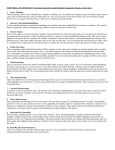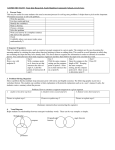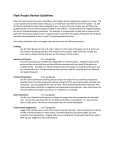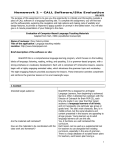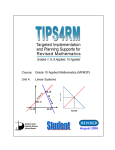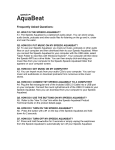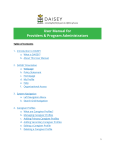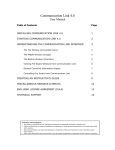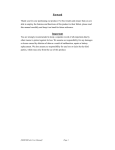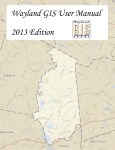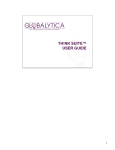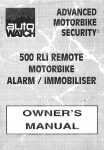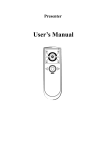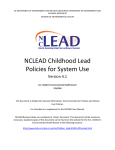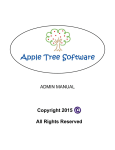Download FAMILY AND CONSUMER SCIENCE From Kim Huegerich, South
Transcript
FAMILY AND CONSUMER SCIENCE From Kim Huegerich, South Hamilton Community Schools, Jewell, Iowa 1. Power Thinking After presenting various ways of doing things, concepts, vocabulary, etc., the students can categorize food groups to determine balanced meals, types of sewing tools, types of housing, types of fashion, etc. You can give them a list of items and they have to provide the category (Power 2) or you can give them the power 1 and power 2s and they provide the details. Offering blank/empty powers provides an aspect of creativity. As long as they can justify their answers, they are doing thought-provoking activities. 2. Selective Underlining/Highlighting As they read a cookbook, list of recipes, etc, have them highlight the ones they are going to prepare to complete a balanced meal. As they read an article on contraception, they can highlight main ideas and details. This could be used in conjunction with power thinking, using a different color for each power as they read. 3. Pattern Puzzles Write out the steps to a process (preparing a recipe, sewing a pillow, following directions for_______), cut apart each step and have the students put the steps back in order. Anything that involves a process is a great candidate for pattern puzzles. This can be used to introduce a concept or review a concept. For example, to introduce a process, do the above. Each student/group may come up with a different process. Have them explain why they chose to do it the way they did. You can question their procedure by providing “what if” scenarios based on their process. This allows them to “experiment” with the procedure without the element of safety concerns. 4. Think-Pair-Share This is sometimes called Think-Ink-Pair-Share (TIPS). Anytime you have them do a worksheet or textbook problem, this is an ideal time for this. They think about the answer, “ink” it, share their response with a partner and then share/demonstrate with the whole class. This builds in wait time for the slower students, builds confidence because they are sharing and validating their answers with another student (collaborative work, teamwork skills), possibly even some reciprocal teaching may be going on if their answers don’t agree, and then sharing one thought-out answer with their peers. The key is that the student is doing the processing, not the teacher for the student. 5. Mind Streaming This is a great way to assess the students’ background knowledge. In pairs, a topic is given, such as nutrition, child rearing, a cooking tool, a process or any other concept. One student talks for 1 minute, saying everything s/he knows about the topic. The other student may not say anything, however gestures such as nodding or smiling may be used. At the end of the minute, the roles are reversed. The second student may repeat what the first student said, but again must continue talking for the whole time. 6. ABC Brainstorming This is also another way to elicit background knowledge about a topic or to review already demonstrated material. You can use the whole alphabet or just a few letters. You can assign certain letters to a group of students/individuals. This is a quick way to find out what the students already know or have learned. 7. Carousel Brainstorming A question or topic is posed to the class (What does healthy eating mean? What are the risks of sexual activity? What are the qualities of home furnishings and appliances?) The students work in groups or independently to come up with an answer. Ideas are shared oneby-one as you go around the room (carousel). The ideas can be gathered and used in a later discussion or answers can be discussed right away. 8. Three-Minute Pause After explaining and modeling a new concept, put kids in groups of 3, identifying person A, B, and C. Each student speaks for 1 min. You may choose to do more or less, depending on the topic, objective, personalities of kids. Student A: explains the concept.; Student B: continues the explanation; Student C: asks a question. Encourage students to ask a question that they may know the answer to just to practice developing questions. It makes kids think and verbalize the process one more time! This usually works best immediately after an explanation as the brain wants to organize the information, provoking students to talk about it. 9. Read-and-Say Something When reading a complex process or text, break it into “chunks”. This could be paragraphs or smaller sections between bolded headings. Students read in pairs or small groups. Each reads the chunk and one-by-one the students paraphrase each section. Depending on the text, they could add comments about any connections they make (text to text; text to self, text to world). An alternative to this is to “read-and-write something”. The same concept is there, but they are writing independently, rather than discussing. They can form groups after reading/writing and discuss what they wrote. Using only their notes, they can come up with a new text to explain what they read. 10. Read-Recall-Check-Summarize This is very similar to #9, but this usually involves a process. They continually ask themselves (check) if what they are reading/summarizing (recall) makes sense (summarize). 11. Magnet Summaries You can have them discuss all four “magnets” or just 1-2 or a different one each day/piece. Different students/groups could have different magnets. For example, if the topic was “qualities of home furnishings and appliances”, some of the magnets might be performance, safety, cost, quality, efficiency, space, clean ability, etc. If the topic was “health”, some of the magnets might be personal, emotional, physical, and sexual. Concept/idea/vocab #1 Concept/idea/vocab #2 performance Main idea Concept/idea/vocab #3 safety appliances/furnishings Concept/idea/vocab #4 quality space 12. One-Sentence Summary After explaining a concept, and giving the students time to work on the idea in class, ask them to summarize what they have learned into one sentence. This can be done on a sticky note or orally as a “ticket out”, or “ticket in” to the room the next day, to ensure brevity in their explanation. It is a quick way to assess whether the students understood your objective. 13. Problem-Solving Organizer Select a problem that has multiple steps (measure parts with metric and English systems, set up and use portable drills, demonstrate welding of ______materials, etc.) The following graphic is put into a worksheet format. The students can combine written explanation with pictorial explanation such as in a user’s manual. Lastly, the students create a summary about the process. 2. student writes first step here Picture to explain step 1. Problem: How to design _______. 2. Student writes second step here 3. Student writes third step here Picture to explain step 2. Picture to explain step 3. (Summary statement about designing ________.) 14. Concentric Circles After discussing the different housing styles, have each person summarize one of them (no more than 4 usually works best). They write their summary on a note card, paper, etc. In two circles, or two lines facing each other, they use the notes they wrote to explain the element, process, etc to the other person. They then trade cards and rotate, moving one person to the left/right. They should have a new concept to explain. The explanation process continues. Rotate. Repeat until all concepts have been reviewed. 1 2 3 4 1 2 3 4 3 4 1 2 3 4 1 2 15. Sticky Note Discussion As students read a text, see a demonstration, hear a process, they make comments, questions, connecting (text to text, text to self, and text to world) statements about what they see/hear. These are later used to answer questions and create deeper discussions. 16. Discussion Webs These are used to create a debate about an issue. The center offers a debatable question. One side offers the pros and the opposite, the cons to the issue. Challenge students to take the side against their personal view to evoke deeper thinking. pro #1 pro #2 pro #3 pro #4 pro #5 Controversial question/topic con #1 con #2 con #3 con #4 con #5 17. Seed Discussions After starting a conversation/explanation or towards the end of a “unit” as a review, students create a seed question that will result in a deeper discussion. This may be a problem-solving topic, such as you have just been hired as an interior designer. Questions may include budget, types of materials to be used, where to get the materials, special needs to be taken into account, etc. 18. Roles within Cooperative Groups As “hands-on” teachers, this could take on a whole new look than traditionally seen in classrooms. When working together on a project, each person could have unique restaurant duties. As one type of job is happening in the restaurant, other students could be planning the next step, critiquing the current job, be a “gopher”, or become the “buser”. 19. (QAR) Question-Answer Relationships This involves using a textbook or user’s manual and answering questions about what is read. By knowing the type of questions that are asked, the answer can be found quickly. There are two types of questions: In the Book and In my Head. In the Book questions can be divided into two additional types of questions: Right There and Think and Search. These questions can be found in the book, as the name suggests. In my Head can also be divided into two additional types of questions: Author and You and On my Own. These types of questions the student must think a little deeper about them. Often students try to look for an answer that isn’t there. Helping them to realize that a question should come from their background knowledge and not from the book can be a revelation to them. 20. Reciprocal Teaching Anytime a teacher can create a situation/environment in which students are teaching their peers is an ideal situation. We remember 90% of what we teach another person. Getting students to summarize, question, clarify and then predict is how they will teach other students. Anytime a student has a question and you think another student knows the answer or can figure it out, send him/her to that student. It will boost their confidence and force them to go through the process and explanation again. 21. KWL Plus Introduce a new appliance/procedure to the students. K: they identify what they already know…this could be from their own experience with a parent, or what they’ve seen/read W: they will be creating a project using it so…what do they want (need) to know about this process in particular? L: after it has been practiced….what is new/unique to this tool/procedure? What did they learn, transform, change? The “plus” of this strategy is to get the students to identify categories of information in the Know, so that they can identify what they Want in order Learn. Categories could be buttons, uses, cost, storage, vocabulary used, etc. 22. Anticipation Guides This gets at what they already know (background knowledge). It can identify misconceptions they have of child rearing, daycare, sexual practices, sexual roles, use of ______, interior design, etc. This could be done via a checklist, agree/disagree. This may serve as a pre-/post- test. In between, the students create a project, discover new ideas, etc, and then see if they were correct in their original evaluation of the concept. 23. Concept Map Students create a concept map, breaking down the concept into deeper, more detailed descriptions. This can be combined with powers. _______ emotion_______ / nutrition ___\ health / \ sexual \_______ personal 24. Comparison Organizer Helps students see comparisons, similarities and difference between concepts and vocabulary items. These can become very complex in nature. Paring knife carving knife dry measuring cups liquid measuring cups butter knife Difference #1 Difference #2 Difference #3 Difference #4 Difference #5 In-home daycares Similarity #1 Similarity #2 Similarity #3 Similarity #4 Similarity #5 Daycare centers Difference #1 Difference #2 Difference #3 Difference #4 Difference #5 25. Sequence Organizers This is for step-by-step processes, such as choosing fabric for a piece of furniture, curtains, pillows, or steps to making a recipe or a sewing project. The students are the ones becoming the meaning-makers by creating the steps rather than just listening to them or reading them. This could be a recall situation in which they are recreating the steps that they have already done. Step 1 Step 2 Step 3 Step 4 Step 5 26. Picture Notes As you explain how to use a piece of equipment, the students are taking notes in the form of pictures. “A picture is worth 1000 words” would best describe this strategy. For the visual learners, this is the preferred method. Often, the lower-achieving students are the ones who prefer to take notes via pictures. The non-traditional students are the hands-on learners. This is also a great alternative to note taking while watching videos. 27. Content Frames This is used to see relationships between concepts. Students/class will write comments in each blank explaining the particular item. Speed of loss Consequences Effectiveness Death rate ABC XYZ Diet #1 Diet #2 Diet #3 Diet #4 28. Semantic Feature Analysis This is similar to a content frame, except the students are just identifying whether the diet has each characteristic or not. Quick weight loss High effectiveness Physical damage 123 Diet #1 + + + Diet #2 + Diet #3 + + Diet #4 + + + has this characteristic - does not have this characteristic 29. Two-Column Notes In column two, students list the definition or explanation of the concept in column one. This could take on the look of three-column notes if you wanted to add another column for a picture/graphic or an example. Cultural cuisines japanese italian mexican indian 30. Observation Entries/You Ought to be in Pictures This is used to imagine what life was like “way back when”. You could show pictures of how cooking utensils, sewing methods or quilting were used at the turn of the century, have students guess what they were for, if no longer used or available, describe/explain what replaced that use, the advantages of modern machinery, etc. 31. RAFT (Role, Audience, Format, Topic) Students take on the role of another person or inanimate object. They must describe or explain another operation. For example, a student may choose to be a piece of fabric (Role) looking for its family (Topic: finished quilt or article of clothing). This could be done via a want-ad (Format) through the eyes of the newspaper reader (Audience). 32. Writing Templates This is a quick way to know if students understand the objective. This is similar to a one-sentence summary except they are completing a few sentences in their own words to summarize the lesson/concept. For example…Measurements can be made using a variety of tools, such as ________________. When measuring___________, the best tool for the job would be ________________ because… 33. Word Map This involves great knowledge of a particular vocabulary word. The student must “dissect” the word and put it back together without repeating any words/vocabulary. A full understanding of the term is necessary. 34. Frayer Model This strategy uses the characteristics of a vocabulary word or concept. It identifies the essential and nonessential characteristics as well as examples and non-examples. Sometimes overgeneralization takes place so identifying what something is not is better than actually identifying what it is. Essential characteristics Non essential characteristics What it must have What it may have Examples What is it? Definition, in own words Non examples What is it not? Antonym





